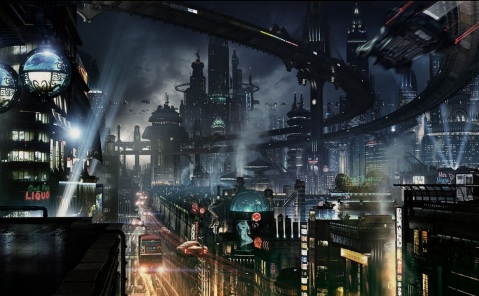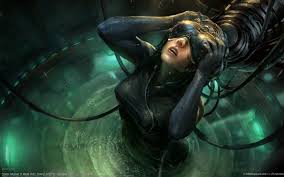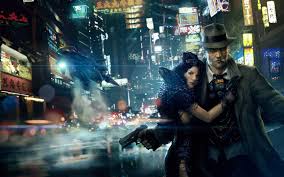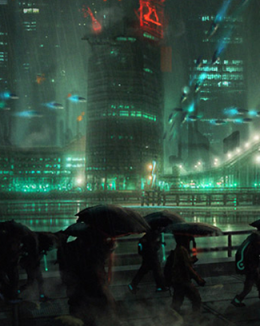First of all, what is Cyberpunk?
This sub-genre of science fiction focuses on a dystopian earth whose inhabitants are, mostly-speaking, techno-punks – criminals, misfits, or disillusioned geniuses who utilise cyberspace as their playground. The genre can be found in all areas of media entertainment: books, films and games, including board and role-playing games, and has even influenced fashion and music. William Gibson and Neal Stephenson are the best-known ‘fathers’, though the quintessential film (and thus image) of cyberpunk is Bladerunner, which is loosely based on Do Androids Dream of Electric Sheep, a novel by Philip K Dick.
But what elements are needed to make a book truly ‘cyberpunk’?
1. Dystopian Earth
 Cyberpunk is usually based on a near-future Earth, rather than some far-flung, futuristic alien world. Technology has become deeply enmeshed in everyday human existence – so much so that an individual might struggle to survive without it. Chances are famine, climate or resources are highly challenging in this world, and governments are either powerless, or corrupt, meaning law and order are often arbitrary. Society has become fractured, leaving yawning holes for misfits, loners and criminal ‘punks’ to slide through. This shadowy ‘underworld’ is fuelled by console-riding jockeys, hackers and jackers, who operate on the dark side of cyberspace, often within the internet landscape of the future.
Cyberpunk is usually based on a near-future Earth, rather than some far-flung, futuristic alien world. Technology has become deeply enmeshed in everyday human existence – so much so that an individual might struggle to survive without it. Chances are famine, climate or resources are highly challenging in this world, and governments are either powerless, or corrupt, meaning law and order are often arbitrary. Society has become fractured, leaving yawning holes for misfits, loners and criminal ‘punks’ to slide through. This shadowy ‘underworld’ is fuelled by console-riding jockeys, hackers and jackers, who operate on the dark side of cyberspace, often within the internet landscape of the future.
2 High Tech, Low Life
 The people of a cyberpunk world have grown up with advanced technology supporting and controlling them. They might well have cybernetic enhancements, special jack-points in their neck or skull to allow direct interfacing with their cyber environment. They might spend most of the day plugged into the digital world, even neglecting their physical bodies for days at a time. Alternatively, they may have artificial limbs, eyes and other senses, they may have additional memory storage, or direct ‘wi-fi’ connection to various systems via a link in their brain. Often these characters will be operating under the radar, out of sight of the government or megacorporations which want to control or abuse them. While the protagonist might not necessarily be fighting against these organisations, their activities are seen as undesirable, thus making them criminals or targets. With resources tight and privileges limited to non-existent, the only power an individual has is in cyberspace, provided they can hide from the megacorps’ digital bloodhounds.William Gibson is the king of cyberpunk, so try his short stories.
The people of a cyberpunk world have grown up with advanced technology supporting and controlling them. They might well have cybernetic enhancements, special jack-points in their neck or skull to allow direct interfacing with their cyber environment. They might spend most of the day plugged into the digital world, even neglecting their physical bodies for days at a time. Alternatively, they may have artificial limbs, eyes and other senses, they may have additional memory storage, or direct ‘wi-fi’ connection to various systems via a link in their brain. Often these characters will be operating under the radar, out of sight of the government or megacorporations which want to control or abuse them. While the protagonist might not necessarily be fighting against these organisations, their activities are seen as undesirable, thus making them criminals or targets. With resources tight and privileges limited to non-existent, the only power an individual has is in cyberspace, provided they can hide from the megacorps’ digital bloodhounds.William Gibson is the king of cyberpunk, so try his short stories.
3 Hardboiled Noir
 Cyberpunk has a distinct style, reminiscent of the old Noir movies, or the hardboiled detective novels of the 40s and 50s. The characters are often cynical, sometimes bitter, and at best prefer not to get involved in other peoples’ problems. However, the protagonists often find themselves in a position where they have little or no choice about which path to choose. So we have reluctant heroes, or anti-heroes – the disillusioned, the malcontents, misfits or criminals – trying to make good in a world where there is no justice and nobody is on their side.Try my own novel, High Tide in the City for a taste of this. End of shameless plug.
Cyberpunk has a distinct style, reminiscent of the old Noir movies, or the hardboiled detective novels of the 40s and 50s. The characters are often cynical, sometimes bitter, and at best prefer not to get involved in other peoples’ problems. However, the protagonists often find themselves in a position where they have little or no choice about which path to choose. So we have reluctant heroes, or anti-heroes – the disillusioned, the malcontents, misfits or criminals – trying to make good in a world where there is no justice and nobody is on their side.Try my own novel, High Tide in the City for a taste of this. End of shameless plug.
4. Megacorporations
Governments in a cyberpunk novel can take one of two forms. They are either pathetic and powerless, or they are all-powerful oppressors. In many cases, they are secretly controlled by one of the megacorporations – vast organisations which control Earth’s planetary resources, services and industries. These organisations are inevitably corrupt, faceless and care nothing for the people their decisions affect. Their interest is primarily power, and the only thing they can’t truly control is cyberspace. Thus, they wage war on it, and attempt to stamp out the kind of person our protagonist might be. Ready Player One by Ernest Cline is a recent cyberpunk that features big business and gaming culture and is now being made into a film by Stephen Spielberg.
5. Cyberworld
 Since the only freedom an individual has is in cyberspace, it’s little wonder the megacorps want to control it, and the individual wants to live there. How cyberspace is depicted in a novel depends on the author’s interpretation, but a projected future might involve full sensory immersion, where it’s possible to do everything: eat, sleep, get drunk and have sex within the cyberworld. Data stacks become buildings, forums become night-clubs or dens. Everything you can currently do in the real world will be represented there, online, for people to experience. In many cyberpunk novels, this ‘cyberworld’ is where much of the action and interaction takes place (think Matrix). It might be depicted as a photo-real ‘world’ with trees, butterflies and dog poop, or as a pulsing neon grid with fluorescent data-flows and foldable work spaces. William Gibson’s Neuromancer coined the phrase cyberspace, so it’s good place to get familiar with cyberpunk.
Since the only freedom an individual has is in cyberspace, it’s little wonder the megacorps want to control it, and the individual wants to live there. How cyberspace is depicted in a novel depends on the author’s interpretation, but a projected future might involve full sensory immersion, where it’s possible to do everything: eat, sleep, get drunk and have sex within the cyberworld. Data stacks become buildings, forums become night-clubs or dens. Everything you can currently do in the real world will be represented there, online, for people to experience. In many cyberpunk novels, this ‘cyberworld’ is where much of the action and interaction takes place (think Matrix). It might be depicted as a photo-real ‘world’ with trees, butterflies and dog poop, or as a pulsing neon grid with fluorescent data-flows and foldable work spaces. William Gibson’s Neuromancer coined the phrase cyberspace, so it’s good place to get familiar with cyberpunk.



Pingback: Wokulski romantyk czy pozytywista, czyli czy bliżej nam do steampunku czy cyberpunku – Ta od reaktorów
” In many cases, they are secretly controlled by one of the megacorporations – vast organisations which control Earth’s planetary resources, services and industries. ”
If Cyberpunk would have massive popularity, Could left-wing politicians use this critic to capitalism to rise a socialist dictatorship? A second Soviet Union in a western country? USA?
LikeLiked by 1 person
Not really. Have a look at the works of William Gibson to get the general idea.
LikeLike
Pingback: Part 2: Blade Runner 2049: fembots and Asian window dressing | Writers Anon - Taunton's Writing Group
Pingback: Blade Runner 2049: a cyberpunk world of fembots and Asian window dressing | Writers Anon - Taunton's Writing Group
Pingback: 5 “Cyberpunk” elementai | Kitty Writer
Pingback: Technologizacja świata, niekoniecznie dobrą przyszłością | Poczytnik
9. Dehumanization- The inhabitants of the cyberpunk dystopia have begun the process of dehumanization of themselves, seeking technology to replace physical body parts and the few natural humans that remain are part of Humanist movements to preserve the human body in its natural state. Usually this creates conflicts between pro-Transhumanists and the anti-Transhumanists which divide and fracture society into multiple philosophical ideologies. The question prevalent would be “What it means to be truly human?” This question is one of the core aspects of any cyberpunk and dystopia scenario and it is about questioning the value and representation of our humanity.
LikeLiked by 2 people
That’s a great addition. Thanks
LikeLike
the Dehumanization element was more less covered in High Tech, Low Life – “They might spend most of the day plugged into the digital world, even neglecting their physical bodies for days at a time. Alternatively, they may have artificial limbs, eyes and other senses, they may have additional memory storage, or direct ‘wi-fi’ connection to various systems via a link in their brain. ”
I suppose the deeper philosophical questions that concept presents aren’t made as clear though.
LikeLiked by 1 person
Yes, I agree. Dehumanisation says it better because it infers the philosophical debate, which is central to cyberpunk.
LikeLike
6. It takes the “strong AI” position, that it is possible for a piece of software to be aware that it exists.
7. America is supplanted as top-dog by some other up-and-coming power. Neuromancer it was Japan, dating it terribly. Today it would be China, possibly dating it again.
8. The narrator and/or characters do not take time out to explain the technology they are dealing with. Cyberpunk is an attempt to write a potboiler contemporary to the latter decades of this century and assumes the audience already knows the basics, much like a novel set in 2014 will not stop to explain how a character is using his or her tablet. The result is the reader is left in a constant state of future shock.
LikeLiked by 1 person